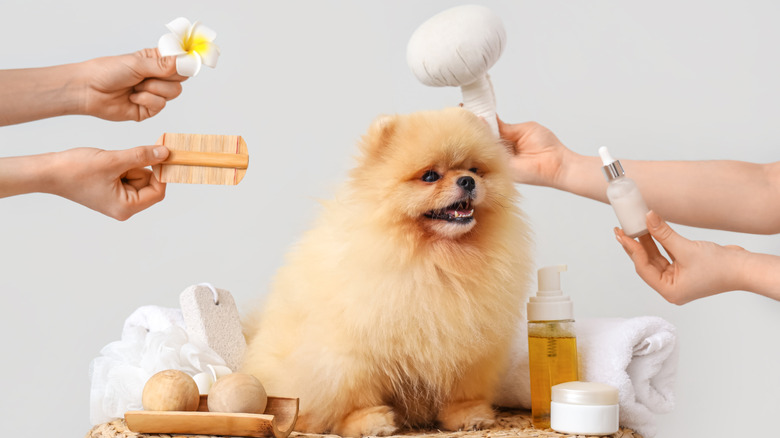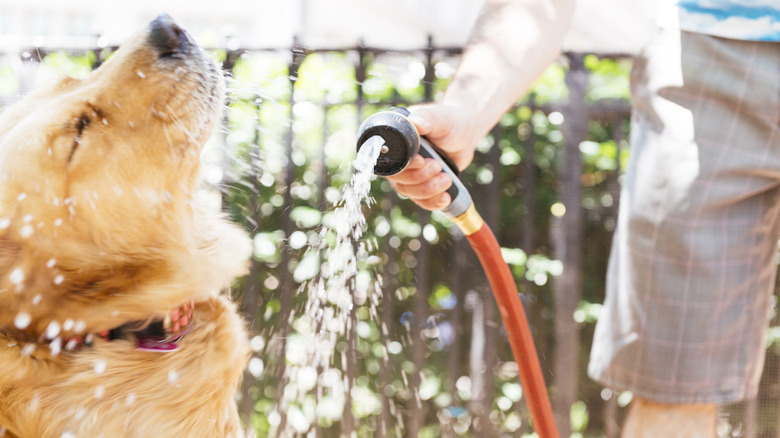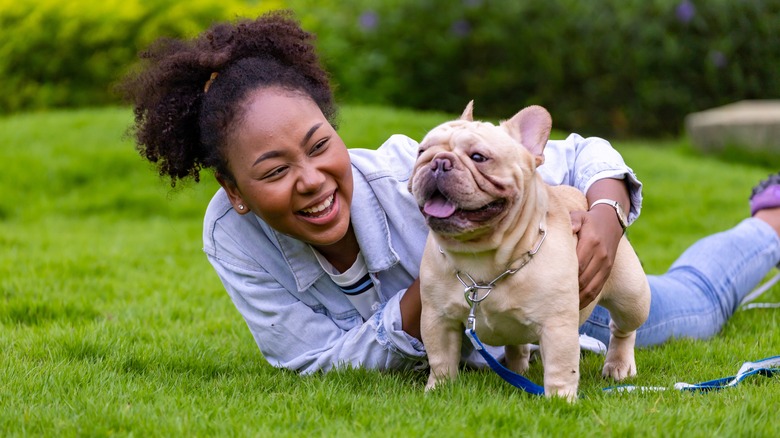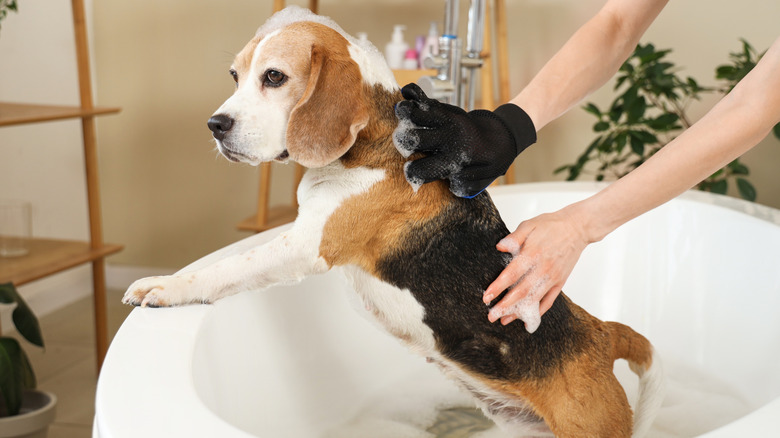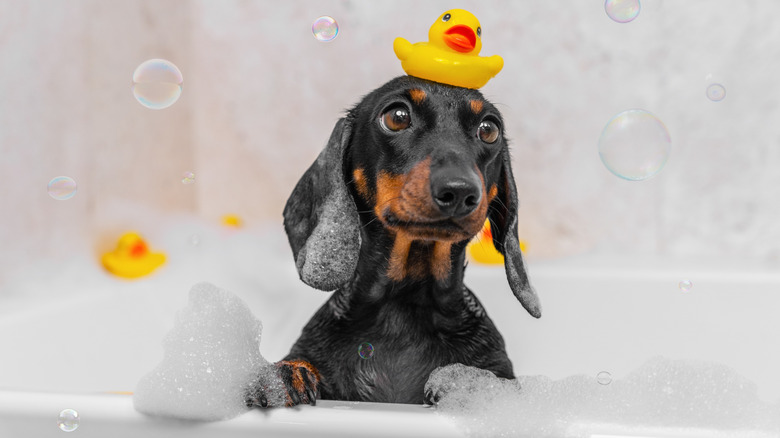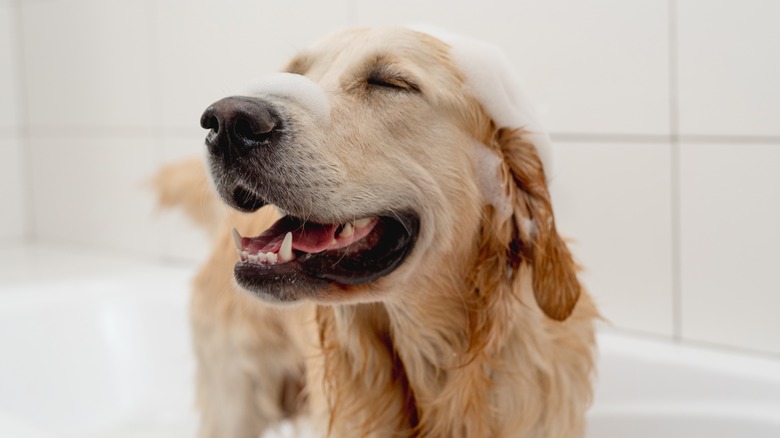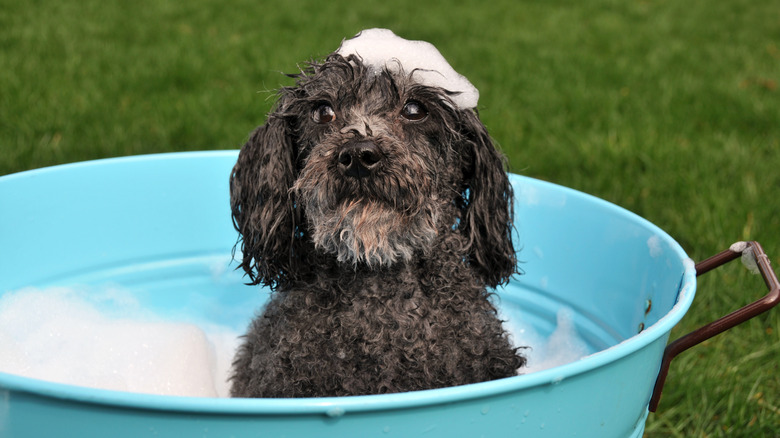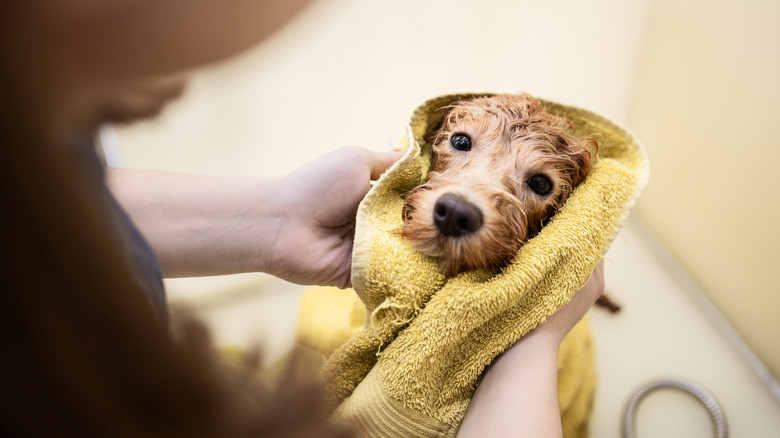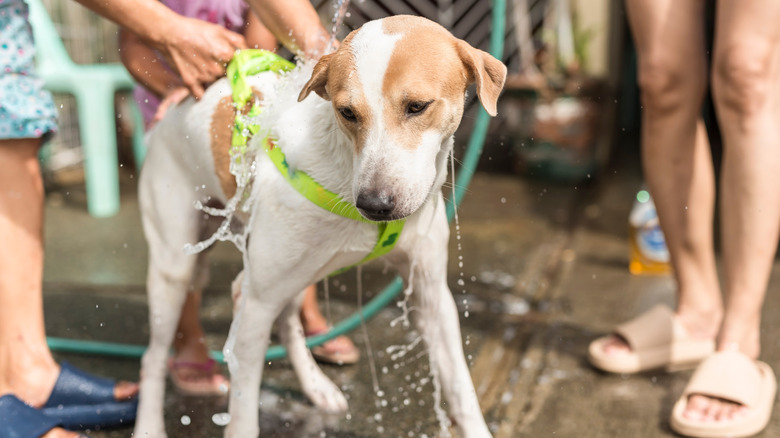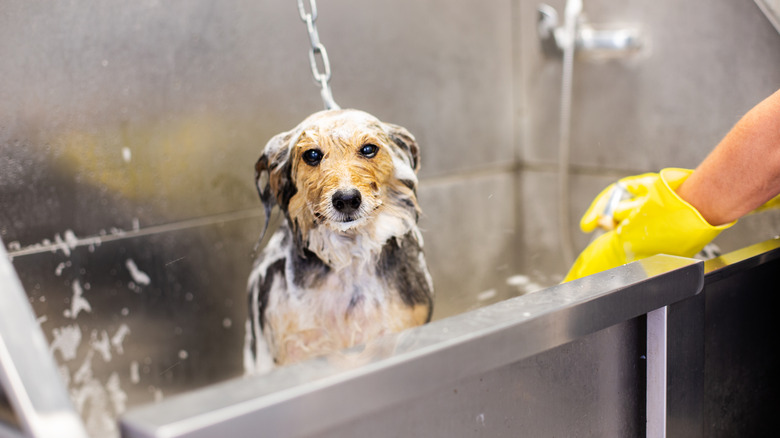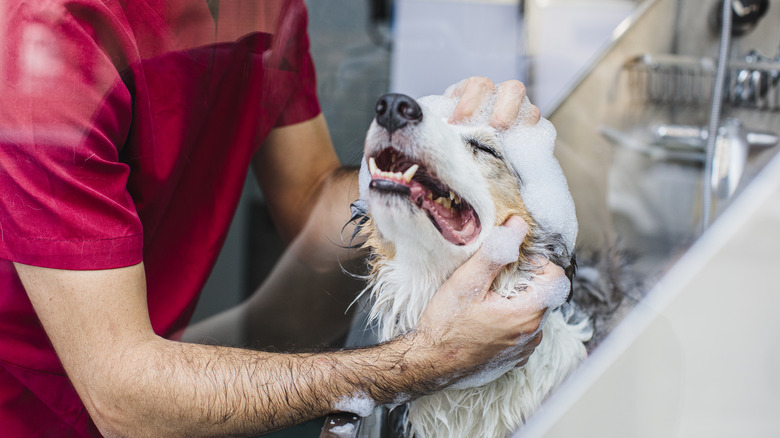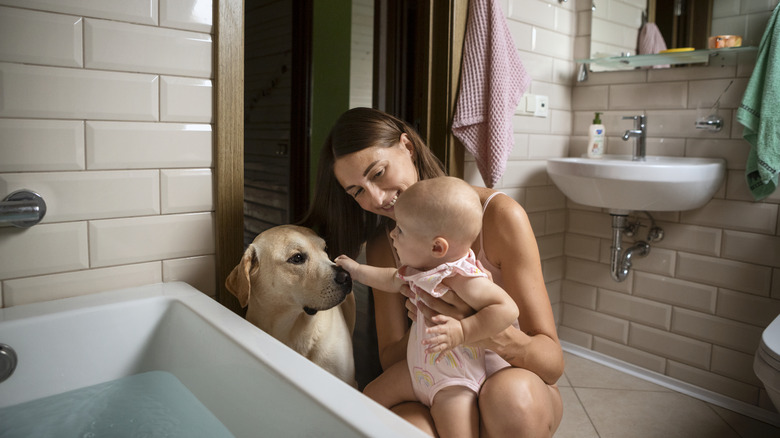13 Tips To Make Bathing Your Dog So Much Easier
We may receive a commission on purchases made from links.
It happens to every dog owner eventually: the dreaded "dog drop and roll" in poop or any other stinky thing — some of them long since dead. Or, maybe your pup needs some help with a particularly oily coat or has been having too much fun in mud puddles. Either way, there eventually comes a time when you can't dodge the challenge of giving your dog a bath.
Every once in a while, you'll win the jackpot and have an easy bather: All you have to do is brush your pup out, wet it down, suds it up, lather, rinse, and maybe repeat a few times, depending on just which stinky or dirty pestilence you're trying to exorcise from its fur. For other dogs, the endeavor is almost as easy as wrestling greased-up piglets at the county fair.
Still, a savvy dog owner does not go into the encounter unprepared. No — a smart dog owner starts by being intimately familiar with their pet's personality and triggers, then collects all the tips and tricks they can to ensure everyone has a smooth, if wet and sudsy, encounter around the bathtub.
Make a list of dog bath supplies and gather them in advance
Nothing signals the start of wet, soapy (or muddy) chaos quite like having to leave your half-washed dog to grab some essential supply you've forgotten — then coming back to find that the dog's gotten out of the tub, or maybe the dog is still in the tub but now most of the water isn't. Honestly, bathing a dog means you're probably going to end up wet too, no matter what, but collecting all your supplies beforehand gives you a head start at containing the mayhem and maybe escaping with the room around you still mostly dry. Besides, it's always good to have a plan, right?
So, here's what you need: On top of the obvious dog shampoo, round up a brush to remove loose fur beforehand, plenty of towels for both you and the dog, and don't forget to outfit yourself in whatever clothes you don't mind getting wet and maybe also dirty. What about conditioner? Maybe; some experts say it's essential to keep your dog's skin and fur from drying out, while others argue that it's optional. You'll need water, of course; a handheld sprayer is by far the easiest option but, if you don't have access to that in a dog-friendly area, you can use a bowl or small bucket to pour water over your dog. Depending on your dog and what sort of fur it has, you might also want a dog-specific blow dryer on hand; they're gentler and quieter than the human version.
Choose where you'll bathe your dog
Once those essentials are covered, it's time to think about the location of the bath. If you need restraints to keep your dog within arm's reach, don't wait until it's gotten wet and wiggly to go find them. Similarly, if you're working in a bathtub or even a sink for small dogs, a non-slip mat helps eliminate the ice-capades-and-circus combo act that sometimes crops up. Finally, if you're working indoors and don't have a spectacular hair trap on your drain already, your plumbing bill will thank you if you buy one or, in a pinch, put steel wool over the drain to keep fur from going into the plumbing.
For big dogs, the bathtub is often the ideal bathing ground. There's enough space, and the bathroom around it is generally meant to handle a soaking. However, that doesn't mean the bathtub is your only option. Some owners love spraying their dogs down with a garden hose and adjustable sprayer outside, even though it means giving up control of the water temperature, while owners of small dogs might prefer using the kitchen sink or a utility sink. Shower stalls work, too, but it's almost impossible to make that happen without getting right in there and getting a little wet, too.
Lastly, don't forget that you always have the option of going to the professionals. Most grooming salons and many veterinarians are set up to bathe your dog for you, and some also offer self-service grooming stations that you can use — all for a fee, of course.
Give your dog a workout before bath time to make everything easier
Just as with any other potentially fraught encounter with your dog, getting your dog tired out before bath time will make things a lot easier for both of you. You want their bodies and minds to understand that playtime has already happened — not that it's just starting once the water turns on and the dog shampoo comes out. Even if your dog is a natural couch potato who only breaks a (figurative) sweat under great duress, doing something to tire them out mentally before the bath, like a short training session, can help make the whole process go more smoothly.
Remember, this tactic works in many other situations. Need to trim your dog's overgrown nails? Exercise it first. Can't get it to sit still for brushing or to take medication? Try again after a run or a good play session. If your dog gets stressed out about hopping in a carrier to go to the groomer, you guessed it: A good training session or workout beforehand might make that go more easily, too.
Brush your dog out before bath time to ease the process
If your dog has mats and tangles in its fur, bathing it won't help those — in fact, bathing your dog will make those mats and tangles worse. Similarly, never pull at those mats and tangles with a brush; it doesn't help. Instead, tackle them with a special anti-tangle brush, trim them out, shave them out, or secure a professional groomer's help if you need it. Once that's done, you'll be ready to turn your thoughts to bathing again.
Even if your dog isn't matted or tangled, brushing it before a bath will still help remove loose hair, pull out any debris in its fur, and ensure you're not just washing fur that's going to end up in the drain anyway. Choosing the right brush for your dog depends on its coat. You might be able to get away with just a slicker brush, or you might need a pin brush too. You can even use a grooming glove to "brush" the dog with your hand. If your dog has a very thick, dense undercoat you may need a full-on grooming rake, like the FURminator, to effectively remove loose fur. These tools are also known as undercoat rakes.
Ease into bathing your dog slowly
While some dogs are drawn to water like a magnet — Newfies, we're looking at you! — others are more hesitant. Add in the extra steps of the grooming process, from brushing to shampooing, wiping your dog's face, and handling almost its entire body, and that's a lot of stimulation for any dog to handle.
With that in mind, whether you're starting with a puppy or with an older dog whose attitude about baths and handling is still a mystery, start out slow. That could mean just a gentle wash with lukewarm water and a washcloth to start, or it can mean dividing the grooming process up into small steps: Hopping into the bathtub, hearing water running, seeing the grooming tools, getting brushed, handling body parts for a touch-averse dog — you get the idea. Then, approach things one step at a time, taking the time to monitor your dog's reactions and let its comfort level dictate how quickly you progress.
Don't be shy about using treats, toys, and affection to help your dog build a positive association with bathing. If you play your cards right, you may end up with a dog that joyously hops into the bathtub on command, ready for its full spa treatment.
Distract your dog for an easier bathing experience
Not every dog is going to fall in love with the bath treatment. That's all right, and it doesn't mean you've done anything wrong; it just means that your dog doesn't love being soaped up and scrubbed. However, you still need a way of getting them clean. Distractions are one thing that can help ease the process.
Enter the almighty peanut butter. You can slather it on the wall about where you want your dog's head to be during bath time, then let it lick it off, pack it into a durable chew toy like a classic Kong, or smear it on a silicone lick mat like the Gorilla Grip Lick Mat, which you can suction-cup to the wall or floor. However you deploy it, peanut butter and any other soft, smearable, lickable treats at your disposal are a great way to keep your dog occupied — and distracted — while you handle the business of bathing it.
Give thick-furred dogs some extra bath time
The same short-haired, single-coated dogs that don't need frequent baths don't typically need long baths, either. However, if your dog is double-coated with a thick undercoat, if it has a water-resistant coat, or if it simply has a lot of long fur, you may need more time and water to get them wet all the way through.
Make sure you use plenty of mildly warm water — not hot or cold — and give said water plenty of soak time to work into your dog's fur. Check to make sure your dog is wet all the way through on its undercarriage, its armpits, and along its tail — three places humans easily forget. You may need to rinse each spot a few extra times too, once you've finished the soaping process.
Have a plan for scrubbing your dog in the bath
Once your dog is wet all the way through, it's time to bring on the suds. Gravity is your friend: Start from the top of your dog, usually around its shoulders, and work your way down and back from there. Work in the same direction your dog's fur grows and, once your dog has been thoroughly shampooed, rinse it while working in the same pattern.
Are you worried about your thoroughly wet, sudsy dog shaking itself off on you — plus anyone and anything else that might be even remotely nearby? You should be. Luckily, trainer Ken Steepe of McCann Dog Training offers the perfect solution: "Keep your hand on your dog's head. Just a little bit of pressure will prevent them from doing that shake." That, he says, buys you enough time to drape a towel over your dog to start the drying process.
Get your dog all dried off after a bath
Congratulations — at this point in the process you have a dog that's clean, if still soaking wet. For dogs with short fur, a simple towel dry, or maybe even a dog-drying coat, might be all you need. For those with long fur, consider squeezing the excess water out of their fur before you go for a towel dry. Leaving your dog's fur wet makes it more prone to mats and tangles, so you get extra points if you're able to persuade your dog to stand still while you blow dry it.
Be wary of human hair dryers, which are hotter than those made specially for dogs. If you do use a human hair dryer, make sure it's on the low setting. As you dry it, brush your dog's fur gently in the same direction it grows. Not all dogs will tolerate the sound of a hair dryer. You might have luck using a tool like the Happy Hoodie — basically, a snug fabric tube that goes over your dog's ears — to reduce the noise and discomfort of blow-drying, but if your dog simply won't tolerate it, you might have to stand pat with the towel dry.
Use tethers to make bath time easier for both of you
Nobody likes to restrain their dog unnecessarily — but nobody likes wrestling a panicked, sudsy dog, either, and if you've ever tried to squeeze a bar of soap under running water, you already have an idea of how that wrestling match is likely to turn out. While some docile dogs might stand still for bathing, a wiggly dog requires humane restraints. The simplest is a leash and collar, although if your pup normally wears a leather collar, it may shrink or tighten up while wet. Consider swapping it for a nylon collar that won't shrink, even if you only make the substitution during bath time.
If you're serious about grooming at home, you could invest in any number of grooming restraints that typically dangle from a rack above your grooming surface. One of the simplest options is a no-sit haunch holder — a strap that loops beneath your dog's abdomen from above, staying comfortably loose while they stand but offering enough support that they cannot lower their haunches to sit. Finally, don't forget the cheapest, easiest type of restraining help you can ask for — a set of helping hands from a friend that your dog already knows and trusts.
If you're going to use special restraints for grooming, it's critically important that you never use them as a punishment. Both you and your dog will reap enormous rewards if you go the extra step of proactively helping your dog build positive associations with the restraints: Start slowly, give lots of treats, make sure your dog stays comfortable, and progress only as fast as your dog is ready for.
Sort out how often your dog needs to be bathed
We humans may need to bathe every day, but that's not the case for dogs. How often your dog needs to be bathed depends largely on its breed, although some medical conditions may come into play too. For example, Basset hounds and other breeds with oily coats need more frequent bathing, sometimes as often as once a week. Short-haired dogs typically need bathing less frequently, as do breeds with coats that are naturally water-repellent. Dogs with dense, double-coated fur, like malamutes, can be particularly hard to bathe, so it's good news that they'll often benefit more from rigorous brushing than from a bath.
Age and activity levels factor into your dog-bathing frequency, too: Young, active dogs tend to get into more mischief, some of it stinky, so you may find yourself bathing them more frequently than a mature dog or a natural couch potato. On the other end of the spectrum, older dogs struggling with incontinence may need a little more hygiene help — but as long as you stay on top of matters, you can probably get away with pet-friendly wipes, hygienic trims, and spot cleaning instead of full-on bathing.
Bottom line? Unless your vet has told you that your dog needs to be bathed more frequently for medical conditions, you can hold off until they smell like they need it — or if you want to be on a regular schedule, once a month is usually plenty.
Talk to your vet about your dog's special needs
Very frequent baths can actually harm your dog's skin and fur leading to health issues like dry or flaky skin. Just as for humans, bathing your dog too frequently can strip away the oils that help keep their skin and fur healthy. On the other side of the equation, bathing your dog may help manage some health issues, such as allergies or an over-oily coat; and medicated shampoos can help treat irritated, itchy skin or combat parasites like fleas and ticks.
As always, your veterinarian is your number one ally in untangling the web of relationships between your dog's inherent medical issues and any environmental concerns around you that may be affecting its skin and fur. If you suspect your dog has an issue that may need more frequent bathing, or even medicated solutions, scheduling an appointment with your vet first is best.
Know some things not to do when giving your dog a bath
At the end of the day, the number one tip for bathing your dog — and making it easy — is to know them well. If you understand your dog's needs, observe their reactions, and adjust accordingly, you'll find the best way of working with them to get the job done. However, there are a few "don't do" commandments that you should be mindful of.
The first is never to spray water straight into your dog's face or ears. Not only is that a surefire way to turn them off the idea of bath time, it also sets them up for possible ear infections. For the same reasons, you should never pour water straight over your dog's head or ears. Another big no-no: Don't use human shampoo on your dog's fur. They need shampoo with a different pH than we do, and human shampoo can leave residue on your dog's fur that is toxic if ingested.
Lastly, never be rough with your dog during bath time. All that achieves is creating negative associations with the experience. If you find yourself getting too frustrated to continue, it's time to take a step back and see what you can change to make the experience easier on both of you — or even find a professional dog groomer who can help.

